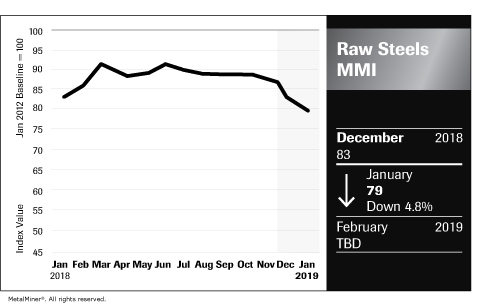Raw Steels MMI: Domestic U.S., China Steel Prices Still Falling
The Raw Steels Monthly Metals Index (MMI) fell again this month, dropping to 79 points. The current MMI index has fallen toward October 2017 levels of 79, before global steel prices started to rise sharply.
Need buying strategies for steel? Request your two-month free trial of MetalMiner’s Outlook
The recent slowdown in domestic steel price momentum led to the decline. Domestic steel prices recently fell fairly sharply, driven by slower Chinese demand and ample steel availability.
Domestic steel prices have showed slowing momentum since June 2018. They increased sharply at the beginning of the year, driven by a bullish market in commodities and industrial metals, as well as by the Section 232 tariffs. During most of 2018, domestic steel prices remained at seven-year highs.
However, steel prices have showed slower momentum recently and prices appear to have started a sharp downtrend. MetalMiner does not expect prices to increase in the short term, although mills may try to shore up prices with price increase announcements.
Meanwhile, plate prices have decreased at a slower pace. Plate price movements are commonly sharper. In other words, plate prices tend to move in one direction and then change sharply. Lower availability has kept domestic plate prices from falling too far, but domestic prices fell in December.
Historically, steel prices in general tend to drift lower during the beginning of Q4 and then rise. In 2017, HRC domestic prices started to increase in December, then skyrocketed during the first quarter of 2018. In 2018, prices did not increase in Q4. MetalMiner does not expect domestic steel prices to increase in the short term.
Chinese Steel Prices
So far in January, prices for all forms of Chinese steel have also fallen. Chinese domestic steel prices started to decrease at the end of October, driven by the start of the winter season.
Chinese steel domestic demand appears weaker, and a slower Chinese economy has driven the recent price decline.
The yuan traded sideways this month. However, current levels are back at 2016 levels, or 0.14 U.S. dollar/yuan. A weaker yuan makes Chinese goods more appealing, despite the U.S. tariffs. Meanwhile, the Chinese stock market (FXI Shares) fell again this month. The Chinese stock market has fallen during most of 2018 after reaching a peak at the beginning of the year. The new downtrend comes as a result of a slowdown in China.
What This Means for Industrial Buyers
Current domestic steel prices appear in a downtrend. Adapting the “right” buying strategy becomes crucial to reduce risks. Only the MetalMiner monthly outlooks provide a continuously updated snapshot of the market from which buying organizations can determine when and how much of the underlying metal to buy.
Click here for more info on how to mitigate price risk all year round – and take a free trial of our Monthly Metal Buying Outlook.
Actual Raw Steel Prices and Trends
The U.S. Midwest HRC 3-month futures price fell again this month by 6.31%, moving to $712/st. Chinese steel billet prices fell this month by 3%, while Chinese slab prices fell by 1.27% to $529/mt. The U.S. shredded scrap price closed the month at $353/st, dropping by 1.4% from last month.






Leave a Reply